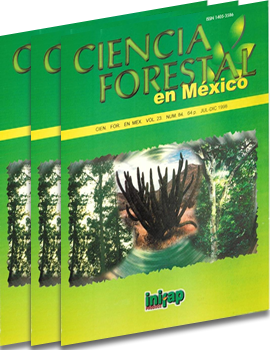CALENTAMIENTO EN AGUA DE LA MADERA DE ENCINOS COMO UNA ALTERNATIVA PARA MEJORAR SU PROCESO DE SECADO
Keywords:
forest industry, lumber heating, drying, oaksAbstract
One of the limitations in the utilization of oaks has been the lumber drying process due to the excesive time and cost requiered when it is performed in conventional kilns and to the long time and defects developed in lumber when it is air dried. In order to improve the process in relation to the reduction of defects in lumber and the drying time, vaporization, planning, pressing and incising tretments previously to the drying process have been analyzed. As another alternative oriented to reduce the drying time, in this work the lumber heating effect in water has been evaluated in relation to the increment in permeability and plasticity to speed up the drying process without increasing the defects. Fer this analysis sawn lumber 4/4" thick of three oak species were used: Quercus candicans. 372 board feet (bf); Q. laurina, 200 bf; and Q rugosa, 316 bf. Half of the lumber of these three species was heated up in water in a metalic container for 7 hours al 70 ºC. This lumber was combined with the other half without treatment, and then air dried and conventional kiln dried. Previously to the drying process the quality of the lumber was determined and the splits. twist, cup, bow and crook were quantified; in order to define the drying effect. these parameters were evaluated again al the end of the process. In general, the drying rate of the lumber treated and untreated was similar in both drying systems, air drying was performed in 71 days and kiln dried in 17 days. In the air drying process, Q. laurina was the best regardless of the heating treatment. The treatment was helpful only to Q. candicans. In the kiln drying process Q rugosa was the best in quality, and the behaviour of the untreated lumber was similar to the heated lumber. The most prominent defects were splits, cup and crook, in both drying systems
Downloads
Downloads
Published
How to Cite
Issue
Section
License
The authors who publish in Revista Mexicana de Ciencias Forestales accept the following conditions:
In accordance with copyright laws, Revista Mexicana de Ciencias Forestales recognizes and respects the authors’ moral right and ownership of property rights which will be transferred to the journal for dissemination in open access.
All the texts published by Revista Mexicana de Ciencias Forestales –with no exception– are distributed under a Creative Commons License Attribution-NonCommercial 4.0 International (CC BY-NC 4.0), which allows third parties to use the publication as long as the work’s authorship and its first publication in this journal are mentioned
The author(s) can enter into independent and additional contractual agreements for the nonexclusive distribution of the version of the article published in Revista Mexicana de Ciencias Forestales (for example, include it into an institutional repository or publish it in a book) as long as it is clearly and explicitly indicated that the work was published for the first time in Revista Mexicana de Ciencias Forestales.
For all the above, the authors shall send the form of Letter-transfer of Property Rights for the first publication duly filled in and signed by the author(s). This form must be sent as a PDF file to: ciencia.forestal2@inifap.gob.mx
This work is licensed under a Creative Commons Attribution-Noncommercial 4.0 International license.



